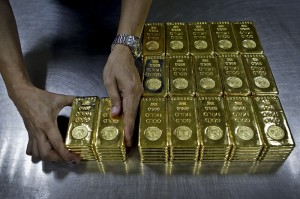Gold in steepest plunge in 30 years

A technician prepares 1 Kg gold bars of 995.0 purity to pack for delivery at the Emirates Gold company in Dubai, United Arab Emirates, in this Oct. 9, 2012, file photo. As of Monday, April 15, 2013, gold has plunged more than 10 percent the last two days, suggesting that a decade-long surge in the metal is over. AP PHOTO/KAMRAN JEBREILI
NEW YORK—Gold had its biggest one-day drop since 1983 on Monday as a selling frenzy that began last week picked up speed.
The price of gold plunged $140.30 to $1,361.10 an ounce, a decline of 9 percent. The metal has dropped $200 an ounce, or nearly 13 percent, in the last two trading days. It’s the lowest price since February 2011.
The sell-off started Friday when the government reported a drop in inflation. Investors often buy gold when they’re fearful of rising prices and sell it when they see inflation ebbing.
A proposal last week that Cyprus sell some of its gold reserves to support its banks also spooked investors, leading them to worry that Spain, Italy and other weak European countries might flood the market just as demand for the metal is weakening.
After the sharp drop last week, the rush of selling started to feed on itself Monday as worried traders hurried to get out of the market.
“This is panic, this it isn’t organized at all,” said Phil Streible, a senior commodities broker at RJ O’Brien Futures.
Worries about slowing growth in China also pushed down industrial metals and the price of oil and other commodities.
Gold is often thought of as a safe-haven investment, a place to park money when investors are fearful of turmoil in other markets, inflation, weak economic growth or depreciation in the value of the US dollar.
It rose sharply in the past decade, from less than $330 ten years ago to a peak of $1,900 an ounce in August 2011 during the market turmoil that followed a downgrade of the U.S. government’s credit rating.
Part of the rise in recent years can be attributed to more investors putting money into gold and speculating that the price will continue to rise. Some investors also bought gold as an alternative to holding dollars on the belief that the Federal Reserve’s economic stimulus program would weaken the US currency.
George Gero, precious metals strategist at RBC Capital Markets, said the possibility of European central banks selling gold was especially worrisome since there were fewer nations interested in keeping gold reserves these days.
“There aren’t many other countries that want to buy,” Gero said. “In the past you saw Mexico, Russia, China, Turkey and other central banks buying gold, but right now there seems to be more of a need for dollars.”
Gold has been declining from a recent high of $1,792 on Oct. 4 as the outlook for the US economy improved, diminishing the metal’s appeal as a safe haven investment. Since then it’s down $431, or 24 percent.
Some Federal Reserve officials have also been calling for an early end to the central bank’s bond-buying program. If that happens, it would likely cause US interest rates to rise, resulting in a stronger US dollar. That would give traders another reason to sell gold, since they see the metal as an alternative to holding dollars.
Silver fell even more than gold, by 11 percent. Silver lost $2.97 to $23.361 an ounce, its lowest price since October 2010.
Industrial metals also fell after China reported that economic growth slowed unexpectedly in the first three months of the year. The world’s second-largest economy grew by 7.7 percent over a year earlier, slowing from the previous quarter, and short of many private-sector forecasts that growth would accelerate slightly to 8 percent.
Copper, which tends to follow the outlook for global growth, dropped 7.7 cents, or 2.3 percent, to $3.27 a pound.
Palladium dropped $42.10, or 5.9 percent, to $667 an ounce and platinum dropped $71.10, or 4.8 percent, to $1,424.80.
Agricultural futures also ended lower. Wheat fell 21 cents to $6.9375 a bushel, corn fell 11.75 cents to $6.4675 a bushel and soybeans fell 18 cents to $13.95 a bushel.
Crude oil dropped to a four-month low, as the slowdown in China’s growth added to doubts about the strength of the world economy and global demand for crude.
Benchmark crude fell $2.58, or 2.8 percent, to finish at $88.71 a barrel on the New York Mercantile Exchange.
In other futures trading on the Nymex:
— Wholesale gasoline fell 4 cents to finish at $2.76 a gallon.
— Heating oil dropped 4 cents to end at $2.83 a gallon.
— Natural gas fell 9 cents to finish at $4.14 per 1,000 cubic feet.—Steve Rothwell
